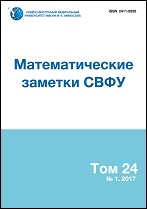|
Mathematical modeling
Calculation of conditions for joint laying of overground pipelines
V. V. Grigorieva, P. E. Zakharova, A. S. Kondakovb, I. G. Larionovaa
a M. K. Ammosov North-Eastern Federal University, Institute of Mathematics and Informatics, 42 Kulakovsky Street, Yakutsk 677000, Russia
b Institute of Oil and Gas Problems of the SB RAS, 20 Avtodorozhnaya Street, Yakutsk 677000, Russia
Abstract:
Long-term experience in the operation of water supply systems in permafrost conditions shows that the most rational method is the above-ground joint laying of pipelines for various purposes. In the Far North regions, with low winter and high summer temperatures and great difference between day and night temperatures, it is a problem to establish conditions for the joint laying of cold and hot water pipes with heat supply pipes in one bundle. The problem is that because in the cold water pipe the water is under pressure and moves only when it is used, so it can freeze at night and thus destroy the pipe. A numerical solution of the two-dimensional temperature problem by the finite element method is considered to determine the optimum intertube distance for the joint laying of cold water supply pipes, heat supply and hot water supply ensuring the permissible water temperature in the cold water supply pipe. In conclusion, optimal intertube distances are obtained for two different schemes of laying pipes so that cold water did not freeze in winter and did not overheat in summer.
Keywords:
polypropylene tubes, temperature insulation, mathematical modeling, tube bundle, intertubular clearance.
Received: 12.08.2017
Citation:
V. V. Grigoriev, P. E. Zakharov, A. S. Kondakov, I. G. Larionova, “Calculation of conditions for joint laying of overground pipelines”, Mathematical notes of NEFU, 24:3 (2017), 78–89
Linking options:
https://www.mathnet.ru/eng/svfu192 https://www.mathnet.ru/eng/svfu/v24/i3/p78
|

| Statistics & downloads: |
| Abstract page: | 123 | | Full-text PDF : | 137 | | References: | 37 |
|




 Contact us:
Contact us: Terms of Use
Terms of Use
 Registration to the website
Registration to the website Logotypes
Logotypes








 Citation in format
Citation in format 